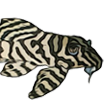Mahapatra, BK & S Kar, 2015. Hara nareshi, a new species of catfish (Pisces: Erethistidae) from the Barak River system of Assam, India. Records of the Zoological Survey of India 115: 31–35.
Moderator edit: In 2024, a color copy of this paper can be downloaded here:
https://faunaofindia.nic.in/PDFVolumes/records/115/01/index.pdf
New Hara
- Silurus
- Posts: 12419
- Joined: 31 Dec 2002, 11:35
- I've donated: $12.00!
- My articles: 55
- My images: 893
- My catfish: 1
- My cats species list: 90 (i:1, k:0)
- Spotted: 424
- Location 1: Singapore
- Location 2: Moderator Emeritus
- Suckermouth
- Posts: 1609
- Joined: 28 Nov 2003, 14:29
- My images: 17
- My cats species list: 22 (i:0, k:0)
- My aquaria list: 2 (i:0)
- My BLogs: 6 (i:0, p:237)
- Spotted: 14
- Location 1: USA
- Location 2: Washington, DC
Re: New Hara
Why is Erethistes and Hara used interchangeably? Peer review should've caught that. Is Erethistes the official genus it's described under because it has the "sp nov" attached to it, even though the paper seems to call it a Hara more often?
- Milton Tan
Research Scientist @ Illinois Natural History Survey
Research Scientist @ Illinois Natural History Survey
- Shovelnose
- Posts: 1240
- Joined: 03 Sep 2008, 09:49
- My articles: 5
- My images: 116
- My catfish: 4
- My cats species list: 60 (i:4, k:0)
- Spotted: 44
- Location 1: Mumbai
- Location 2: India
Re: New Hara
Judging by the drawing of the serrations on the pectoral spine, this should be a Hara and not an Erethistes. I should say this species sounds exceedingly similar to H.hara.
Balaji
Major: Now what's this... stone, stone, stone, (looks down at his hand) and scissors. Now. Scissors cut everything, don't they?
Sergeant: Not stone, sir.
Major: They're very good scissors!!
Major: Now what's this... stone, stone, stone, (looks down at his hand) and scissors. Now. Scissors cut everything, don't they?
Sergeant: Not stone, sir.
Major: They're very good scissors!!
- bekateen
- Posts: 9325
- Joined: 09 Sep 2014, 17:50
- I've donated: $40.00!
- My articles: 4
- My images: 141
- My cats species list: 145 (i:105, k:35)
- My aquaria list: 37 (i:14)
- My BLogs: 45 (i:150, p:2729)
- My Wishlist: 35
- Spotted: 183
- Location 1: USA, California, Stockton
- Location 2: USA, California, Stockton
- Contact:
Re: New Hara
Here's the key to the genus Erethistes, which I extracted from the E. nareshi paper. For some reason the 2015 key is missing even though E. koladynensis was described years before E. nareshi. I've updated the key using current names, and I've taken the liberty to insert E. koladynensis into the key based on its diagnostic characters, beginning with it having 32 vertebrae and a forked tail, and unlike other species so far described, it has a rough anterior surface to the dorsal spine, rather than a smooth or serrated surface. I've changed the font color for that inserted step.
Key to species of genus Erethistes:
Key to species of genus Erethistes:
- Caudal fin emarginated; vertebrae 27-29 [Brahmaputra and Ganges river drainages] ...
- Caudal fin deeply forked; vertebrae 30-35... 2
- Serrations on anterior edge of dorsal spine present [Brahmaputra and Ganges river drainages] … 3
- Serrations on anterior edge of dorsal spine absent... 4
- Upper lobe of caudal fin simple; inter dorsal length 76.9% of adipose dorsal base...
- Upper lobe of caudal fin filamentous; inter dorsal length 75% of adipose dorsal base...
- Anterior surface of the dorsal spine rough, not smooth [Koladyne River]...
- Anterior surface of dorsal spine smooth... 5
- Supraoccipital process reaching anterior nuchal plate; posterior process on coracoid extending three quarters distance between bases of pectoral spine and pelvic fins; total soft pectoral fin rays modally 5 [Sittang River drainage]…
- Supraoccipital process not reaching anterior nuchal plate; posterior process on coracoid extending two thirds or less distance between bases of pectoral spine and pelvic fins; total soft pectoral fin rays modally 6-7… 6
- Length of adipose fin base 10.0-13.7% SL; eye diameter 8.0-9.8% HL [Brahmaputra River Drainage] ...
- Length of adipose fin base 12.9-17% SL; eye diameter 11.2-17.9% HL… 7
- Length of dorsal spine 14.7-19.8% SL; first principal ray on upper lobe of caudal fin not extended into filament [Baw Di Chaung drainage]…
- Length of dorsal spine 20.2-27.6% SL; first principal ray on upper lobe of caudal fin usually extended into filament… 8
- Posterior process on coracoid reaching to two thirds distance between bases of pectoral spine and first pelvic fin ray, its length 23.6-27.0% SL [rivers draining southern extremity of Tenasserim Range]…
- Posterior process on coracoid reaching to midway of distance between bases of pectoral spine and first pelvic fin ray, its length 19.9- 23.9% SL… 9
- Caudal peduncle length 14.9-17.8% SL, depth 6.1-7.2% SL (depth 2.1-2.9 times in its length); body depth 13.9-19.2% SL [Ataran, Salween and Sittang river drainages]...
- Caudal peduncle length 18.8-21.3% SL, depth 5.0-6.1% SL (depth 3.1-3.9 times in its length); body depth 12.5-14.5% SL [Irrawaddy River drainage]…
Find me on YouTube & Facebook: http://youtube.com/user/Bekateen1; https://www.facebook.com/Bekateen
Buying caves from https://plecocaves.com? Plecocaves sponsor Bekateen's Fishroom. Use coupon code bekateen for 15% off your order. Also, for you Swifties: Https://youtu.be/ZUKdhXL3NCw















